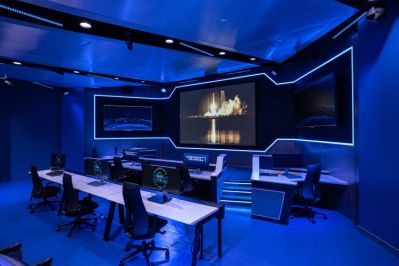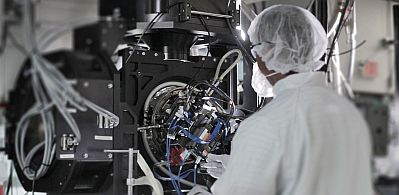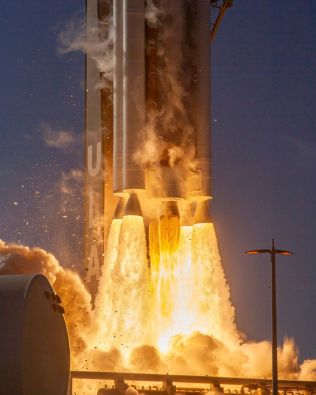Northrop Grumman and Raytheon Combine Knowledge and Resources to Develop Next-Gen Missile Defense
The Next Generation Interceptor is evolving U.S. defenses against increasingly sophisticated ballistic missile threats. The two manufacturers are leveraging advanced manufacturing techniques and a digital collaboration to design, produce and test with speed and agility. Utilizing existing operational facilities, they have already made major strides in building and testing hardware for the Missile Defense Agency's NGI program.

"Production and manufacturing play a central role in our program to ensure we are meeting the timelines required to outpace threats and keep our country safe," said Lisa Brown, Vice President, Next Generation Interceptor (NGI) program, Northrop Grumman.
In today's rapidly evolving threat environment, industry partners need to quickly deploy new capabilities to help customers, country and allies maintain a strategic advantage. That's why Northrop Grumman's Next Generation Interceptor (NGI) program leverages advancing manufacturing techniques and a digital collaboration environment to design, produce and test with speed and agility.
Utilizing existing operational facilities, Northrop Grumman and Raytheon Technologies have already made enormous strides in building and testing hardware for the Missile Defense Agency's (MDA) NGI program.
"We built and tested key components of the Next Generation Interceptor ahead of customer timelines," said Brown. "Early testing of hardware helps reduce risk for the NGI mission."

Northrop Grumman's Next Generation Interceptor (NGI) team completed its Preliminary Design Review one year earlier than the original contract date. (Credit: Northrop Grumman)
Northrop Grumman and Raytheon Technologies' NGI production processes and facilities across the country are fully operational and have a long, successful history of delivering hundreds of launch vehicles, targets, kill vehicles, solid rocket motors and spacecraft. These are the same customer-certified facilities that produce the existing Ground-based Midcourse Defense booster and kill vehicle related technologies.
The Command Center -- Huntsville, Alabama
Huntsville, commonly known as the Rocket City, has a deep history of space and military technology development. Northrop Grumman and Raytheon have a longstanding presence in Huntsville, working critical Department of Defense and space related programs.

Northrop Grumman Missile Defense Futures Lab in Huntsville, Alabama
Today, Huntsville serves as the headquarters for the Northrop Grumman-led NGI team. Due to growth in the program, Northrop Grumman recently expanded its facilities footprint in Huntsville. The combined NGI Huntsville team has moved into the new campus, located just outside Gate 9 of Redstone Arsenal in the Rocket City.
"Co-located Northrop Grumman and Raytheon employees working on NGI in Huntsville help enhance collaboration and operational efficiencies while creating easy access and a transparent environment for customers," said Brown.
A History of Industry Leading Rocket Development
Northrop Grumman's Launch Vehicle Business produces an average of two new launch vehicle configurations each year. Based in Chandler, Arizona, the company has over 60 years of rocket development experience. Today, Northrop Grumman has accumulated over 65 rocket configurations that have successfully flown for customers.
VIDEO: Homeland Missile Defense Scenario
In 2019, Northrop Grumman's Launch Vehicles team moved into a new state-of-the-art facility designed to take advantage of operational efficiencies. Operating for three years, most launch vehicles built at the facility in Chandler are intended for the Missile Defense Agency customer. Northrop Grumman's launch vehicles facility uses lean manufacturing and digital engineering enabling the flexibility to adjust manufacturing needs based on demand.
A Necessary Boost -- Northrop Grumman's Solid Rocket Motor Facilities
Northrop Grumman's large Solid Rocket Motors (SRMs) play a central role in the NGI program.

Northrop Grumman's Next Generation Interceptor arrived at Arnold Air Force Base for full-scale static test fire earlier this year. (Photo Credit: Northrop Grumman)
Northrop Grumman owns one of the only SRM test areas in the country. The company's large SRMs are built in Utah, with motors built in Bacchus, and Promontory and cases produced in Clearfield -- and include more than 5.3-million-square-feet of manufacturing and office building space, spanning over 29,000 acres.
These facilities include unique, market-leading technologies such as the company's automated casting facility that utilizes three 1,800-gallon SRM mixers, the largest of their kind in the United States. Its infrastructure supports medium to large ground tests of the company's produced motors as well as customer motors and lifecycle testing.

At Raytheon's space factory, air is filtered out every 27 seconds to simulate Earth's exoatmosphere where even a miniscule fleck of dust can damage instruments and systems.
Along with mixing, casting and assembling the motors, Northrop Grumman also manufactures an array of rocket motor nozzles used in both solid and liquid launch, while carbon-fiber technologies are used to manufacture the SRM cases at its Clearfield facilities.
A Proven Space Factory
Raytheon Technologies' space factory also plays a critical role in the NGI program. The space factory's roots took hold in the late 1990s, when the U.S. government tasked what is now Raytheon Missiles & Defense with building a system to counter the rising threat of long-range and intercontinental ballistic missiles.
Based in Tucson, Arizona, Raytheon's space factory covers 47,000 square feet and houses more than 60 clean rooms in a spacelike environment. Each one is designed specifically for manufacturing or testing interceptor technologies for successful deployment beyond Earth's atmosphere as a critical component of the United States' missile defense capabilities.

Technicians and engineers support production and testing of complex space hardware at the space factory in Arizona.
The space factory has contributed to 49 successful tests of Raytheon Missiles & Defense capabilities in space. Since the facility expanded in 2015, Raytheon Missiles & Defense has invested $40 million in further modernizing manufacturing. They are also stepping up digital technologies that enable faster and more efficient work in design and testing.
Digital Backbone
Along with the operational facilities that the team brings to the program, Northrop Grumman and Raytheon Technologies' common software factory solution and its associated digital infrastructure will play a central role in delivering the NGI.
NGI's common software factory brings the Northrop Grumman and Raytheon team together with the MDA into a single, agile, secure and efficient development environment, providing the MDA with the ability to review and collaborate on code development and release.

Northrop Grumman produces an average of two new launch vehicle configurations, six GMD booster vehicles and 25 threat-representative ballistic missile target vehicles each year.
The common software factory is equipped with a set of tools, process workflows, scripts and environments configured to produce software deployable artifacts with minimal human intervention. The common software factory also enables transparent collaboration during NGI software development and greatly reduces risk to the program schedule.
Meeting an Accelerated Schedule
These manufacturing facilities, when brought together, enable the Northrop Grumman and Raytheon NGI team to perform early production demonstrations and testing -- reducing risk and enabling timely processes needed to meet the needs of the customer and the warfighter.
Want more information? Click below.
Rate this article
View our terms of use and privacy policy ::m::